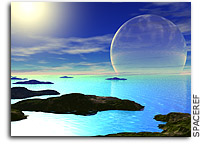NASA Astrobiology Institute to Host General Meeting Feb 10-12.

Nearly 500 scientists from around the world will meet in early February to discuss the latest research on the origin, distribution and future of life in the universe at the 2003 general meeting of the NASA Astrobiology Institute (NAI) to be held at Arizona State University.
The goal of the meeting, which celebrates the NAI’s first five years of research and discovery, is to encompass all aspects of NAI’s mission. The NAI mission includes generating scientific results and new directions, developing collaborations, furthering the use of its technology infrastructure, strengthening its contribution to NASA missions, fostering the next generation of astrobiologists and advancing its education and outreach efforts.
“At the NAI, we ask universal questions of science on a universal scale,” said NAI Acting Director Dr. Rosalind Grymes. “These aspects of NAI, and of astrobiology itself, are reflected in the theme selected for this year’s conference, ‘Living Links through Time and Space: Meeting the Challenges of Interdisciplinary Science’,” she said.
“Arizona State University is pleased to host the 2003 general meeting of the NASA Astrobiology Institute,” said astrobiologist Jack Farmer, principal investigator of the institute’s lead team at ASU, an NAI charter member and the program organizing committee’s co-chair. “Though the nature of the science of astrobiology is highly collaborative on a day-to-day basis, it’s a rare opportunity to be able to meet face-to-face with nearly 500 of our colleagues from around the world and share research at the leading edge of this dynamic field.”
Highlights of the conference include a public lecture on Feb. 11 at 7:30 p.m. by Dr. Antonio Lazcano, president of the International Society for the Study of the Origin of Life (ISSOL), who is based at the Universidad Nacional Autonoma de Mexico (UNAM). Also featured will be a closing lecture on Feb. 12 at 5:30 p.m. by Dr. Donald Johanson, one of the world’s leading paleoanthropologists. In 1974 in Ethopia, Johanson discovered a partial skeleton of a female ‘australopithecine,’ a hominid fossil, which became known as Lucy, our oldest, most complete human ancestor.
A series of plenary lectures will include presentations by Dr. Christopher Chyba of the Center for the Study of Life in the Universe, and Dr. Alan Dressler of the Carnegie Institution of Washington, who will discuss “Life Beyond the Solar System: If, Where, When and How?” More than 300 oral and poster presentations also are scheduled, which span the breadth of astrobiology. In addition, special research sessions have been organized in the areas of:
- Astrobiological Perspectives in Exploring the Solar System
- Evolutionary Genomics
- Searching for Life Outside the Solar System
- Life in Extreme Environments
- Advances in Ecological Genomics
- Early Biosphere Evolution
To register, news media should see:
http://nai.arc.nasa.gov/institute/general_meeting_2003/
and click on ‘press information’ and ‘registration.’ A meeting schedule and abstracts also are available at this site.
The NASA Astrobiology Institute is composed of over 700 researchers located at more than 130 research institutions across the United States. Its central offices are located at NASA Ames Research Center, in the heart of Silicon Valley, California. Additional information about the NAI can be found at its Web site:
http://nai.arc.nasa.gov









